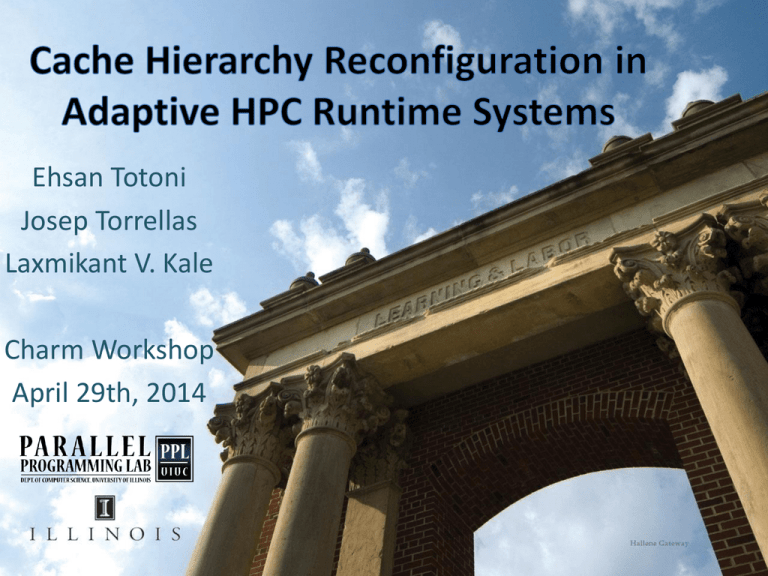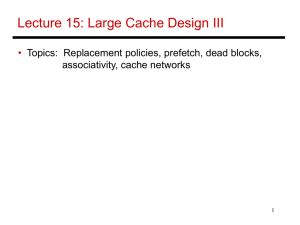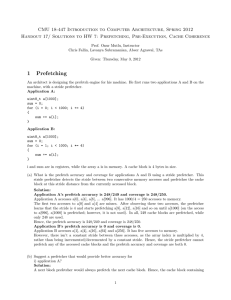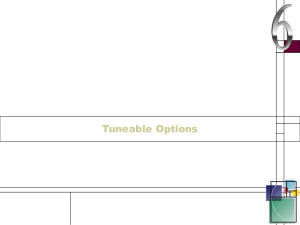Caches - Parallel Programming Laboratory
advertisement

Ehsan Totoni Josep Torrellas Laxmikant V. Kale Charm Workshop April 29th, 2014 • • • • Tianhe-2 ~34 PFlop/s Linpack ~18 MW power Goal: ExaFlop/s at 20MW • ~26 times more energy efficiency needed Top500.org November 2013 2 2 • Caches consume a large fraction of processor’s power – 40% in POWER7, after many techniques • Getting larger every day – Intel Xeon E7-88702: 30MB of SRAM L3 – IBM POWER8: 96MB of eDRAM L3 • Fixed design, but applications are different – E.g. potentially no locality in pointer chasing “Big Data” 3 3 Structure of the HIV cap • Scenario: NAMD on Blue Waters Pentamers introduce – HIV simulations, only 64 million atoms sharp declinations • 48 bytes atom state (position & velocity) • Some transient data (multicasts) • Assuming 400 bytes/atom, 25.6 GB – 4000 Cray-XE nodes • 32 MB of L2 and 32 MB L3 each -> 256 GB of cache! Highly Continuously changing • 90% of capacity not unused • schematic with NAMD!) model; are time, not best usebeads of caches.. not proteins! curvature in the (therehexagonal is nothing wrong lattice – 16 days wall clock Huge waste! 4 4 Ganser, B. K. (1999). • Turning off cache ways to save energy proposed • Two main issues: – Predicting the applications future – Finding the best cache hierarchy configuration • We solve both on HPC systems 5 5 • Many processors are commodity – Not necessarily designed for HPC • Provisioning different than non-HPC – No multi-programming, time-sharing, co-location – Large, long jobs – High Predictability 6 6 • Properties of algorithms in common HPC apps: – Particle interactions (MiniMD and CoMD) • Force computation of entities • Small domain, high temporal locality – Stencil computations (CloverLeaf and MiniGhost) • Update of grid points with stencils • Large domain, low temporal locality – Sparse Linear Algebra (HPCCG, MiniFE, and MiniXyce) • Update of grid points with SpMV • Often large domain, low temporal locality 7 7 0x03…1 0x03…2 0x03…3 1 0x05…3 2 0x07…5 6 0x04…4 0x05…5 3 4 0x07…6 0x07…7 5 7 8 8 0x03…4 0x05…6 8 0x07…8 • HPC applications are iterative – Persistence: Same pattern repeats – RTS can monitor application, predict future • Single Program Multiple Data (SPMD) – Different processors doing the same thing – RTS can try cache configurations exhaustively • RTS can apply best cache configuration – Monitor, re-evaluate regularly 9 9 • RTS tracks Sequential Execution Blocks (SEBs) – Computations between communication calls • Identified by characteristic information – Communication calls and their arguments – Duration – Key performance counters • Usually repeated in every iteration 10 10 • Hierarchical iteration structure Overall iteration PE 0 PE 1 PE 2 sub iter PE 3 11 11 • RTS needs to identify iterative structure – Difficult in most general sense • Using Formal Language Theory – Define each SEB as a symbol of an alphabet Σ – An iterative structure is a regular language • Easy to prove by construction – Each execution is a word 12 12 follows: • In profiling, RTS sees a stream of SEBs (symbols) ssors rocessors er/energy – Needs to recognize the pattern – Learning a regular language from text – Build a Deterministic Finite Automaton (DFA) ors • Prefix r changes ristics are ows from assumed as MPI. can have e13phases Tree Acceptor (PTA) –A for each Fig.state 3. Timeline view ofprefix phases of MILC: time is on x axis and four processors are stacked on y axis. Colors represent different computations. This figure pattern of MILC. – Not tooillustrates largethe inregular our iterative application start qλ a Fig. 4. PTA for sample abc b qa 13 qab c qabc • Mantevo mini-app suite – Representative inputs – Assume MPI+OpenMP – Identify unique SEBs • SESC cycle-accurate simulator – Simulate different configurations for each SEB • Model cache power/energy using CACTI 14 14 Format: <ways turned on>/<total number of ways> Best configuration depends on: • Application type • Input size 15 15 5% Performance Penalty Threshold 67% cache energy saving (28% in processor) on average 16 16 Adapting to problem size is crucial. 17 17 • Streaming: predict data and prefetch for simple memory access patterns – Two important parameters: – Cache size to use – Prefetch depth • Can waste energy and memory bandwidth – Too deep/small cache evicts useful data – Prefetch enough data to hide memory latency 18 18 • RTS can tune cache size and depth – Similar to previous discussion • Hardware implementation: – Prefetcher has an adder to generate next address – One input can be controlled by RTS as a system register – Does not have overheads of repetitive prefetch instructions 19 19 • Small gains in performance might have high energy cost 1 L3 way 2 L3 ways 4 L3 ways 8 L3 ways 1 L3 way 2 L3 ways 16 L3 ways Relative Energy Consumption HPCCG Execution Time (s) 0.18 0.16 0.14 0.12 0.1 0 2 4 8 16 32 64 128 20 16 L3 ways 1.6 1.4 1.2 1 0.8 0.6 0.4 0.2 2 4 8 16 Prefetch Depth Prefetch Depth 20 4 L3 ways 8 L3 ways 32 64 128 • Wrong speculative path is accelerated with deeper prefetch • Intervenes with useful computation 1 L3 way 2 L3 ways 4 L3 ways 8 L3 ways 16 L3 ways 1 L3 way 2 L3 ways 0.1 0.01 0.001 2 4 8 16 32 64 128 Prefetch Depth 1.02 1 2 4 8 16 Prefetch Depth 21 21 16 L3 ways 1.04 Instructions Issued Miss rate of L3 cache 1 4 L3 ways 8 L3 ways 32 64 128 • Automatic cache hierarchy reconfiguration in hardware had been explored extensively – Survey by Zang and Gordon-Ross – Hardware complexity -> energy overhead – Hard to predict application behavior in hardware • Small “window” • Choosing best configuration • Compiler directed cache reconfiguration (Hu et al.) – Compiler’s analysis is usually limited • Many assumptions for footprint analysis – Simple affine nested loops – Simple array indices (affine functions of constants and index variables) • Not feasible for real applications 22 22 • Caches consume a lot of energy (40%>) • Adaptive RTS can predict application’s future – Using Formal Language Theory • Best cache configuration can be found in parallel (SPMD model) – 67% of cache energy is saved on average • Reconfigurable streaming – Improves performance and saves energy – 30% performance and 75% energy in some cases 23 23 • Prototype machine (MIT Angstrom?) and runtime (Charm++ PICS) • Find best configuration in small scale – When exhaustive search is not possible – Using common application patterns • Extend to mobile applications – Many modern mobile apps have patterns similar to HPC! 24 24 Ehsan Totoni Josep Torrellas Laxmikant V. Kale Charm Workshop April 29th, 2014











